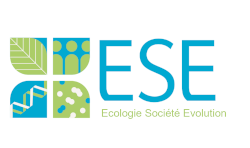Another project developed in the team relates to the study of the domestication of the apple tree and is conducted in collaboration with Amandine Cornille (GQE Le Moulon). Since the discovery in Central Asia of a crab-apple tree (Malus sieversii) carrying relatively large apples and closely related to the cultivated apple tree (M. domestica), it was admitted that this Asian wild species had given rise to our cultivated apple tree. We showed, using hypervariable genetic markers (microsatellites), that the domestication history of the apple tree was in fact more complex: we revealed that the varieties of M. domestica carried in their genomes footprints of recent gene flow from other wild species present along the silk roads, through which the apple tree was brought back to Europe by Romans during their commercial exchanges with Asia. In particular, we detected frequent and recent traces of genetic introgressions (i.e., imports of genomic fragments from a species into another by hybridizations followed by back-crosses) in the genome of the cultivated apple tree coming from the European crab-apple tree, M. sylvestris, disseminated in our European forests. The European crab-apple tree was thus a secondary contributor, but an important one, to the genome of the current cultivated apple tree, to the extent that the varieties of apples currently cultivated in Europe are genetically closer to the European crab-apple tree than to its initial Asian ancestor. Reciprocally, the cultivated apple tree also introgressed the European crab-apple tree to the extent that this threatens the integrity and the genetic resources of the European crab-apple tree. We could show that the introgressions were more frequent in areas more affected by human activities. In addition, we showed that private firms sell seeds of wild apples which are in fact mainly hybrids, or even domesticated apple trees, under ambiguous names. The seeds distributed by the ONF correspond to wild genotypes, but with a very restricted genetic basis, so that a very low genetic diversity is replanted. Our work has fostered new laws for the conservation of the European crab-apple and the set-up of orchards aiming at producing crab-apple seeds for replanting pure genotypes in forests.
By using the same genetic markers, we studied the genetic structure of the European crab-apple tree throughout its geographical distribution in Europe. We showed that this species displays three genetic groups, a group occurring in western Europe, another group more in the east in the Carpates and the last group in the Balkans. This kind of genetic structure is typical of glacial refugia in the south of Europe during the last glaciation: the north of Europe having been covered with an icecap, the plants could persist only in the south in the Iberian, Balkan and of Carpates peninsulas, between which there was no more gene flow, fostering genetic differentiation. During the postglacial warming, the populations recolonized the north of Europe, keeping their genetic structure. Such knowledge of the genetic structure of the crab-apple tree is essential for developing a conservation program for this species endangered by human activities, to preserve its genetic diversity and its potential local adaptation. Our work thus brought a new perspective on the evolutionary history of the apple tree domestication, which has a great economic and cultural importance. We revealed in addition that the European crab-apple tree was threatened by gene flow from the cultivated apple tree and we unraveled its genetic structure, which reflects responses to the past climate changes, thus contributing to predict and maybe mitigate the consequences of the current climate changes.
Another axis of research relates to the studies of introgressions between the cultivated apple tree and the European crab-apple tree, at the whole genome level, and on the adaptive or deleterious role of these introgressions. Our recent work changed the view on the domestication of the apple tree and revealed a threat to the European crab-apple tree because of these introgressions (see “past achievements”). However, we had previously used only 35 genetic markers, in non-coding regions. We are now analyzing the sequences of the complete genomes apple trees. A first goal is to evaluate the importance of reciprocal gene flow between the domesticated apple tree M. domestica and the European crab-apple tree M. sylvestris, at the whole genomic level, both quantitatively and qualitatively. A second goal is to assess whether the European crab-apple tree contributed to traits selected by humans during domestication, such as disease resistance, climate or soil adaptation, or robustness. Reciprocally, we wish to determine if the introgressions of the European crab-apple tree by the domesticated apple tree threatens its persistence, or if in contrast they fostered adaptation, or if they are neutral. More generally, we wish to contribute to understand the evolutionary genomic processes of adaptation that occurred during domestication. These questions are to the forefront of evolutionary biology and have applied consequences, in terms of conservation of endangered species and varietal improvement.
In addition, we are collaborating with an INRA team (C. Lemaire, Angers) to study the consequences of the domestication of the apple tree on the fungus responsible for apple scab, Venturia inaequalis, by sequencing multiple genomes of various areas in Europe and Asia and various apple species. This is also a good model to understand the rapid adaptation to a new environment: the fungus responsible for the scab tree differentiated while adapting to the domestication of its host, and there exists several differentiated populations hybridizing in the zones of secondary contact between the various hosts. The fungal population on the cultivated apple tree appears more aggressive and more generalist than the populations on crab-apple trees. Again, this is thus a good model to understand rapid adaptation to an anthropized environment and the generation of the biodiversity.
